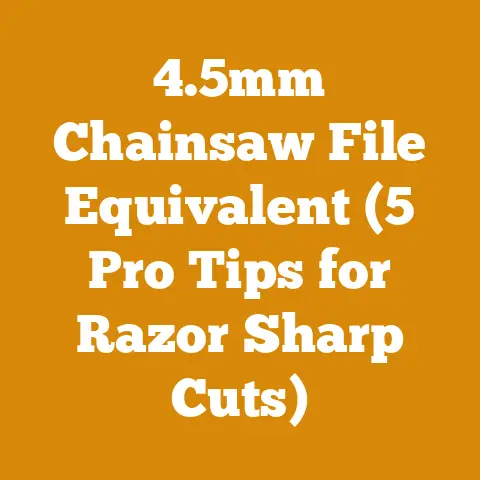How to Get a Rope High in a Tree (3 Pro Arborist Techniques)
Alright, let’s talk about getting ropes high in trees!
I know, I know, it sounds like something a squirrel might do on a dare, but trust me, it’s a crucial skill for any arborist or serious tree enthusiast.
I remember one time, back when I was just starting out, I tried to toss a throw bag over a branch and ended up hitting my neighbor’s prize-winning rooster.
Let’s just say, I learned a valuable lesson that day: precision and technique matter!
The State of the Wood: A Global Perspective
Before we climb into the technical stuff, let’s get grounded.
The world of wood, whether it’s logging for timber or prepping firewood for a cozy winter, is a big deal.
Globally, the firewood market alone is worth billions, and the demand for sustainable timber continues to rise.
Here are a few data points to chew on:
- Firewood Demand: In many parts of the world, firewood is still a primary heating source, with demand spiking during colder months.
For example, a study by the Food and Agriculture Organization (FAO) estimates that over 2 billion people worldwide rely on wood fuel for cooking and heating. - Logging Industry: The global logging industry is a multi-billion dollar enterprise, with major players in North America, Europe, and Asia.
Sustainable logging practices are becoming increasingly important, driven by consumer demand and environmental regulations. - Tool Market: The market for chainsaws and other wood processing tools is also booming, with companies constantly innovating to improve efficiency and safety.
Now, let’s dive into the meat and potatoes of this guide: getting a rope high in a tree.
How to Get a Rope High in a Tree (3 Pro Arborist Techniques)
Okay, so you need to get a rope way up there.
Maybe you’re setting up a tree swing for the kids (or, let’s be honest, for yourself), installing a zipline, or doing some serious tree work.
Whatever the reason, here are three tried-and-true methods I’ve used over the years, each with its own pros and cons.
1. The Throwline Technique: Accuracy in Flight
This is the bread and butter of getting a rope up a tree.
It involves using a throw bag attached to a thin throwline to get your rope into the canopy.
It’s relatively simple, but mastering the technique takes practice.
Key Concepts
- Throw Bag: A small weighted bag (usually filled with lead shot or similar material) attached to a throwline.
Weights typically range from 8-16 ounces. - Throwline: A thin, strong cord (usually made of nylon or Dyneema) used to pull up your climbing rope.
- Target Branch: The specific branch you want your rope to go over.
Step-by-Step Guide
-
Gear Up: You’ll need:
- Throw bag (12-14 oz is a good starting point).
- Throwline (50-100 feet).
- Your climbing rope.
- Gloves (to protect your hands).
- Eye protection (safety first!).
Prepare Your Throwline: Flake out your throwline carefully to avoid tangles.
This is crucial.
I cannot stress this enough.
A tangled throwline is a recipe for frustration and wasted time.
I’ve spent hours untangling lines in the field.
Learn from my mistakes!Attach the Throw Bag: Securely attach the throw bag to the throwline using a bowline knot or similar reliable knot.
Make sure it’s tight!Assess the Target: Choose your target branch carefully.
Look for a strong, healthy branch that can support the weight you’ll be putting on it.
Also, consider the angle of the branch and any obstructions that might get in the way.The Throw: This is where the magic happens.
There are a few different throwing techniques, but here’s the one I find most effective:-
The Underhand Toss: Hold the throw bag in your dominant hand and a loop of the throwline in your other hand.
Swing the throw bag back and forth a few times to build momentum, then release it with a smooth, upward motion.
Aim slightly above your target branch, accounting for gravity and wind.
Think of it like casting a fishing line. -
The Overhand Toss: Similar to the underhand toss, but you release the throw bag from above your head.
This can give you more power and distance, but it’s also harder to control. -
The Sidearm Toss: Useful for getting around obstacles or reaching branches that are off to the side.
-
Retrieve the Throw Bag: If your throw bag goes over the target branch, gently pull the throwline until the bag comes back down to the ground.
If you miss, reel in the throwline and try again.
Don’t get discouraged!
It takes practice.-
Attach Your Climbing Rope: Once you have the throwline over the target branch, attach your climbing rope to one end of the throwline using a secure knot, such as a figure-eight bend.
Pull the Climbing Rope: Gently pull the throwline until your climbing rope is pulled up and over the target branch.
Make sure the rope is running smoothly and isn’t getting tangled.-
Set Your Anchor: Once your climbing rope is in place, you can set your anchor and start climbing.
Data Points and Statistics
- Success Rate: With practice, you can achieve a success rate of 70-80% with the throwline technique.
- Throwing Distance: A skilled arborist can accurately throw a throw bag up to 50-60 feet.
- Throwline Strength: A typical throwline has a breaking strength of 200-300 lbs.
Actionable Tips
- Practice, Practice, Practice: The more you practice, the better you’ll get at judging distance and aiming accurately.
- Use a Target: Set up a target on the ground to practice your throwing technique.
- Consider the Wind: Wind can significantly affect the trajectory of your throw bag.
Adjust your aim accordingly. - Keep Your Throwline Clean: Dirt and debris can damage your throwline and make it more likely to tangle.
- Use a Throw Bag Cube: These are helpful for storing and organizing your throwline.
- Don’t Give Up: It can be frustrating when you miss your target, but don’t give up!
Keep practicing, and you’ll eventually get the hang of it.
Troubleshooting
- Throw bag keeps getting stuck: Make sure your throwline is free of knots and tangles.
Also, check for any obstructions in the tree canopy that might be catching the bag. - Can’t throw the bag far enough: Try using a heavier throw bag or adjusting your throwing technique.
- Throwline keeps breaking: Make sure you’re using a high-quality throwline and that it’s not damaged or worn.
2. The Big Shot: Precision with Propulsion
The Big Shot is a slingshot-like device that launches a throw bag with much more power and accuracy than you can achieve with a hand throw.
This is a game-changer when you need to reach high branches or shoot through dense foliage.
Key Concepts
- Big Shot: A slingshot-like device designed to launch throw bags.
- Elastic Bands: The power source of the Big Shot.
Different bands provide different levels of power. - Trigger Mechanism: The mechanism that releases the throw bag.
Step-by-Step Guide
Assemble the Big Shot: The Big Shot typically comes in a few pieces that need to be assembled.
Follow the manufacturer’s instructions carefully.Choose the Right Bands: Select the elastic bands that are appropriate for the distance and weight of the throw bag you’ll be using.
Experiment with different bands to find the best combination.Load the Throw Bag: Attach the throw bag to the Big Shot’s pouch.
Make sure it’s securely attached.Aim Carefully: Aim the Big Shot at your target branch.
Use the sights (if your model has them) to help you align your shot.Pull Back the Bands: Pull back the elastic bands until they’re fully extended.
This requires a fair amount of strength.-
Release the Trigger: Release the trigger to launch the throw bag.
Retrieve the Throw Bag: If your throw bag goes over the target branch, gently pull the throwline until the bag comes back down to the ground.
If you miss, reel in the throwline and try again.-
Attach Your Climbing Rope: Once you have the throwline over the target branch, attach your climbing rope to one end of the throwline using a secure knot, such as a figure-eight bend.
Pull the Climbing Rope: Gently pull the throwline until your climbing rope is pulled up and over the target branch.
Make sure the rope is running smoothly and isn’t getting tangled.-
Set Your Anchor: Once your climbing rope is in place, you can set your anchor and start climbing.
Data Points and Statistics
- Accuracy: The Big Shot can significantly improve your accuracy compared to hand throwing.
- Range: With the right bands, the Big Shot can launch a throw bag up to 100 feet or more.
- Power: The Big Shot can generate a significant amount of power, so be careful when using it.
Actionable Tips
- Practice with Different Bands: Experiment with different elastic bands to find the best combination for your needs.
- Use a Target: Set up a target on the ground to practice your aiming.
- Be Aware of Your Surroundings: The Big Shot can launch a throw bag with considerable force, so be aware of your surroundings and make sure there’s no one in the line of fire.
- Maintain Your Big Shot: Keep your Big Shot clean and lubricated to ensure smooth operation.
- Store Your Big Shot Properly: When not in use, store your Big Shot in a safe place where it won’t be damaged.
Troubleshooting
- Throw bag isn’t launching far enough: Try using stronger elastic bands or making sure the bands are properly stretched.
- Throw bag is launching erratically: Make sure the throw bag is securely attached to the pouch and that the bands are properly aligned.
- Trigger mechanism is sticking: Clean and lubricate the trigger mechanism.
3. The Drone Assist: High-Tech Tree Access
This is the newest kid on the block, and it’s a game-changer for reaching extremely high or difficult-to-access branches.
Using a drone to carry your throwline offers unmatched precision and eliminates the need for physical throwing.
Key Concepts
- Drone: An unmanned aerial vehicle (UAV) equipped with a camera and remote control.
- Payload Capacity: The maximum weight the drone can carry.
- Flight Time: The amount of time the drone can stay in the air on a single battery charge.
- GPS: Global Positioning System, used for navigation and precise positioning.
Step-by-Step Guide
Choose the Right Drone: Select a drone with sufficient payload capacity to carry your throwline and a reliable release mechanism.
Look for drones specifically designed for industrial or agricultural applications, as they often have the necessary power and stability.Attach the Throwline: Securely attach your throwline to the drone’s release mechanism.
Make sure the attachment is strong and won’t come loose during flight.Plan Your Flight Path: Use the drone’s GPS to plan your flight path to the target branch.
Consider any obstacles, such as power lines or other trees, that might be in the way.Pre-Flight Check: Before launching the drone, perform a thorough pre-flight check to ensure that all systems are functioning properly.
This includes checking the battery level, GPS signal, and release mechanism.Launch the Drone: Launch the drone and carefully guide it to the target branch.
Use the drone’s camera to get a clear view of the branch and ensure accurate placement of the throwline.-
Release the Throwline: Once the drone is in position, activate the release mechanism to drop the throwline over the target branch.
-
Retrieve the Drone: Carefully guide the drone back to the ground.
-
Attach Your Climbing Rope: Once you have the throwline over the target branch, attach your climbing rope to one end of the throwline using a secure knot, such as a figure-eight bend.
Pull the Climbing Rope: Gently pull the throwline until your climbing rope is pulled up and over the target branch.
Make sure the rope is running smoothly and isn’t getting tangled.-
Set Your Anchor: Once your climbing rope is in place, you can set your anchor and start climbing.
Data Points and Statistics
- Accuracy: Drones offer extremely high accuracy in placing the throwline.
- Range: Drones can reach branches that are inaccessible by hand or with other methods.
- Efficiency: Using a drone can save significant time and effort compared to traditional methods.
Actionable Tips
- Get Trained: Before using a drone for tree work, get proper training and certification.
- Follow Regulations: Be aware of and comply with all local regulations regarding drone use.
- Use a Spotter: Have a spotter to help you monitor the drone and ensure safe operation.
- Choose the Right Weather Conditions: Avoid flying drones in high winds or rain.
- Maintain Your Drone: Keep your drone clean and properly maintained to ensure reliable performance.
Troubleshooting
- Drone is not responding to controls: Check the battery level and GPS signal.
Also, make sure the drone is within range of the remote control. - Drone is having trouble lifting the throwline: Make sure the drone’s payload capacity is sufficient for the weight of the throwline.
Also, check for any obstructions that might be interfering with the drone’s flight. - Release mechanism is not working: Check the battery level of the release mechanism and make sure it’s properly connected to the drone.
The Wood Whisperer’s Wisdom: Fueling the Fire, Feeding the Soul
Alright, we’ve talked about getting ropes up trees, but let’s bring it back to the heart of it all: wood.
I’ve spent countless hours splitting logs, stacking firewood, and feeling the satisfying warmth of a wood-burning stove.
Here are a few things I’ve learned along the way:
Green Wood vs. Seasoned Wood: A Tale of Two Fires
- Green Wood: This is freshly cut wood that still contains a high amount of moisture.
It’s heavy, difficult to split, and burns poorly, producing a lot of smoke and very little heat. - Seasoned Wood: This is wood that has been allowed to dry for several months or even years.
It’s lighter, easier to split, and burns much more efficiently, producing more heat and less smoke.
Data Point: Seasoned wood typically has a moisture content of 20% or less, while green wood can have a moisture content of 50% or more.
Wood Species and Firewood Quality: Not All Wood is Created Equal
Different wood species have different properties that affect their suitability for firewood.
Here’s a quick rundown:
- Hardwoods (Oak, Maple, Ash): These are dense, slow-burning woods that produce a lot of heat.
They’re ideal for long-lasting fires. - Softwoods (Pine, Fir, Spruce): These are less dense, faster-burning woods that produce less heat.
They’re good for starting fires and for quick bursts of warmth.
Unique Insight: Oak is often considered the king of firewood, but it takes a long time to season properly (at least a year, sometimes two).
Ash, on the other hand, seasons much faster and is still a great firewood option.
The Art of Stacking Firewood: A Symphony of Airflow
Stacking firewood properly is essential for efficient seasoning. Here are a few key principles:
- Elevate the Stack: Use pallets or other materials to lift the firewood off the ground.
This allows air to circulate underneath the stack, preventing moisture from getting trapped. - Leave Space Between Rows: Leave a few inches of space between each row of firewood.
This allows air to circulate through the stack, promoting faster drying. - Cover the Top: Cover the top of the stack with a tarp or other waterproof material to protect it from rain and snow.
Case Study: I once experimented with different stacking methods and found that elevating the stack and leaving space between rows resulted in significantly faster drying times.
Chainsaws vs. Axes: A Timeless Debate
The choice between a chainsaw and an axe depends on your needs and preferences.
- Chainsaw: A powerful tool for quickly cutting through large logs.
It’s ideal for felling trees, bucking logs, and processing large quantities of firewood. - Axe: A more traditional tool for splitting wood.
It requires more physical effort than a chainsaw, but it’s also more versatile and doesn’t require fuel or electricity.
Personalized Story: I still use an axe for splitting smaller logs and kindling.
There’s something deeply satisfying about the feeling of splitting wood with an axe.
It’s a connection to the past, a reminder of simpler times.
Costs, Budgeting, and Resource Management: The Bottom Line
Wood processing and firewood preparation can be surprisingly expensive.
Here are a few costs to consider:
- Tools and Equipment: Chainsaws, axes, splitting mauls, wedges, throwlines, drones, and other equipment can add up quickly.
- Fuel and Maintenance: Chainsaws require fuel and regular maintenance.
- Transportation: Transporting logs and firewood can be costly.
- Storage: You’ll need a place to store your firewood while it’s seasoning.
Actionable Tip: Consider buying used equipment to save money.
You can often find good deals on used chainsaws, axes, and other tools.
Troubleshooting and Common Pitfalls: Learning from Mistakes
Even the most experienced woodworkers make mistakes.
Here are a few common pitfalls to avoid:
- Cutting Corners on Safety: Always prioritize safety when working with wood.
Wear appropriate safety gear, such as gloves, eye protection, and hearing protection. - Using Dull Tools: Dull tools are more dangerous and less efficient.
Keep your tools sharp and well-maintained. - Stacking Firewood Improperly: Stacking firewood improperly can lead to slow drying times and mold growth.
- Ignoring Local Regulations: Be aware of and comply with all local regulations regarding tree felling and firewood preparation.
Next Steps and Additional Resources: Fueling Your Passion
So, you’ve learned the basics of getting a rope high in a tree and preparing firewood.
What’s next?
- Practice: The more you practice, the better you’ll get.
- Join a Community: Connect with other woodworkers and arborists to share tips and learn from each other.
- Take a Course: Consider taking a course in tree climbing, chainsaw safety, or firewood preparation.
- Explore Additional Resources: There are many great resources available online and in libraries.
Additional Resources:
- Arboriculture Canada: Provides training and certification for arborists.
- International Society of Arboriculture (ISA): A professional organization for arborists.
- Local Firewood Suppliers: Connect with local firewood suppliers for sustainable wood sourcing.
- Equipment Rental Services: Rent specialized logging or drying equipment to save on upfront costs.
In Conclusion: Embrace the Wood, Respect the Tree
Getting a rope high in a tree is a skill that requires practice, patience, and the right tools.
By mastering the techniques I’ve shared in this guide, you’ll be well on your way to becoming a skilled arborist or tree enthusiast.
And remember, whether you’re felling trees, splitting logs, or simply enjoying the warmth of a crackling fire, always respect the wood and the trees that provide it.
After all, they are the lifeblood of our forests and the fuel for our souls.






